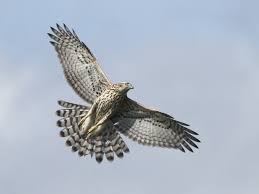
Reports have revealed that key birds of prey are returning to the Dark Peak, but the news surrounding the moorland bird population is not all good.
The Peak District Bird of Prey ‘initiative’ for last year shows goshawks fledging from all eight nests monitored in its study area. This is along with hen harriers returning to nest in the Peak District.
In the southern part of the national park also came the first confirmed breeding of red kite in the Peak District for more than 150 years.
The news was tempered by the death of one of the two young hen harriers a few days after fledging, from what’s thought to be natural causes.
The second chick and both adults also disappeared about the same time.
Two of the eight goshawk nests monitored saw the first confirmed fledging, following around two decades of failed attempts in the same locations.
It comes after co-operation on the ground between raptor groups and gamekeepers.
Cases of reported wildlife crime against raptors in the study area also dropped from several incidents in 2018, to one suspected buzzard poisoning case, plus the believed theft of young from a peregrine nest.
Another peregrine nest was deserted for unexplained reasons following egg-laying.
The group say challenges still remain for the peregrine.
There were just five confirmed nesting attempts, with seven chicks fledged from three successful nests.
The group say: “Eleven merlin nests achieved 41 fledged young, well above target and high enough to encourage an increase in the population.
“The number of breeding pairs remains unstable and saw an overall drop of a third on year-on-year averages since 2012.”
The reasons are unclear, but are in line with UK trends.
More than 40 short-eared owls hatched last year from about a dozen nests, although many are thought to have died before fledging due to poor weather.
Sarah Fowler, chief executive of the Peak District National Park, said: “Whilst these remain challenging times for birds of prey in the Dark Peak, a positive return to breeding for such an iconic species as the goshawk gives us cause for cautious optimism.
“Coupled with a reduction in reported incidents of illegal activity in 2019 - after a troubling series of cases last year - this demonstrates that partnership working with those who manage our upland moorland, raptor working groups and increased awareness amongst our upland communities can deliver results.
“We remain concerned for the peregrine falcon and will be working closely with police wildlife crime officers during the winter to ensure all partners and agencies are ready to minimise the impacts of illegal activity.”
For the 2020 season, the Initiative has said its focus will include measures to deter peregrine egg and young theft alongside the police, encouraging earlier sightings and reporting and increasing joint site visits between gamekeepers and raptor monitoring workers.
The report can be found at https://www.peakdistrict.gov.uk/looking-after/biodiversity/news
Main image:
FLYING HIGH: A goshawk soars in the sky.


 Football and visit to Venice were highlights of Italy trip for Glossop pupils
Football and visit to Venice were highlights of Italy trip for Glossop pupils
 High Peak business owner delighted by police crackdown on anti-social behaviour
High Peak business owner delighted by police crackdown on anti-social behaviour
 Police appeal after motorcyclist is killed in crash on A54
Police appeal after motorcyclist is killed in crash on A54
 Man charged with four thefts from shops in Glossop
Man charged with four thefts from shops in Glossop


